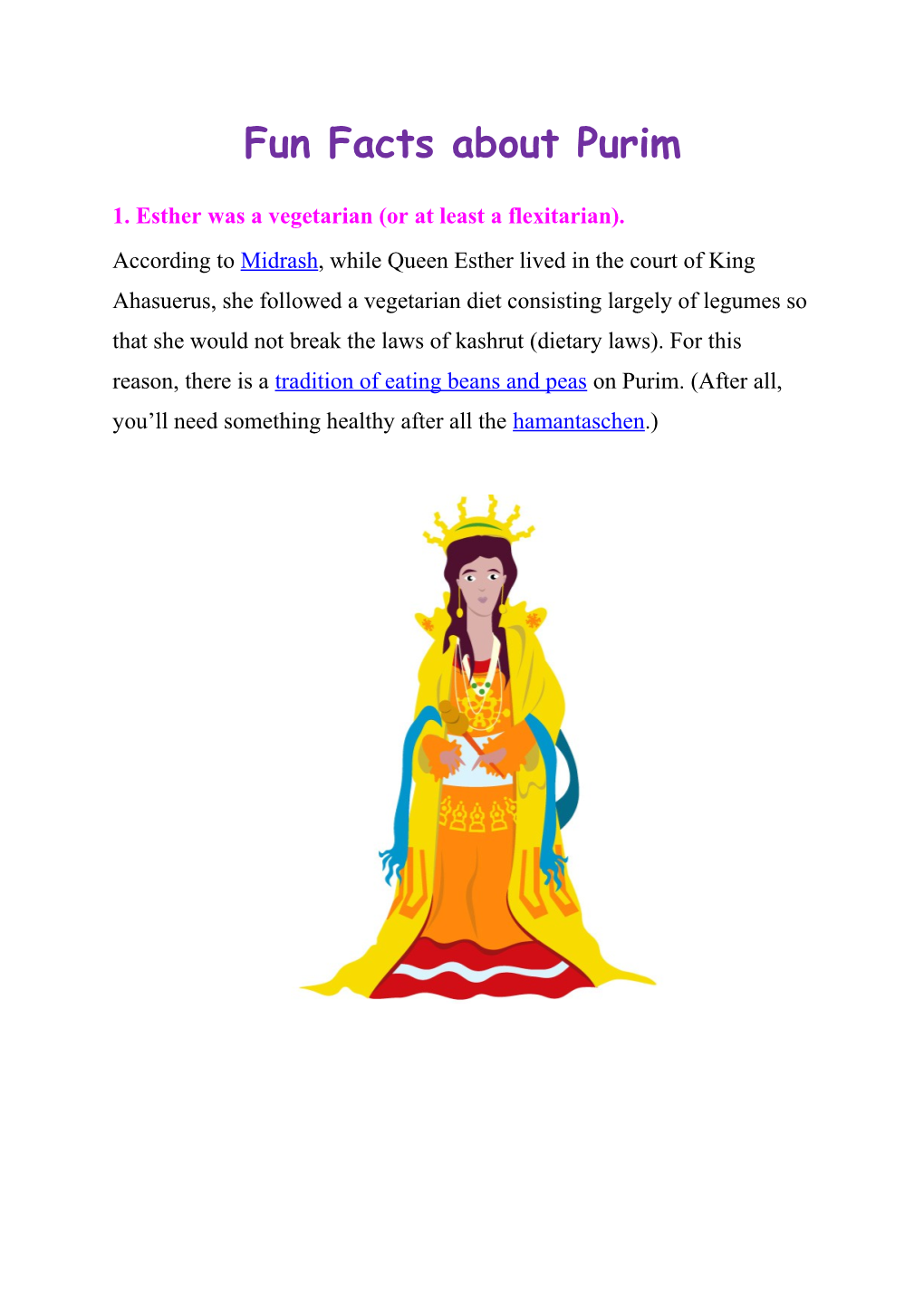Fun Facts about Purim
1. Esther was a vegetarian (or at least a flexitarian).
According toMidrash, while Queen Esther lived in the court of King Ahasuerus, she followed a vegetarian diet consisting largely of legumes so that she would not break the laws ofkashrut(dietary laws). For this reason, there is atradition of eating beans and peason Purim. (After all, you’ll need something healthy after all thehamantaschen.)
2. You’re supposed to find a go-between to deliver your mishloachmanot, the gift baskets traditionally exchanged withfriends and family on Purim.
The verse in theBook of Estheraboutmishloachmanotstipulates that we shouldsendgifts to one another, not just give gifts to one another. As a result, it’s better to send your packets of goodies to a friend via a messenger, than to just give them outright. Anyone can act as a go-between, so feel free to recruit the postal service or even that nice guy in the elevator to help you deliver your gifts.
3. Esther Scroll is the only biblical book that does not include God’s name.
The Book of Esther alsomakes no referencesto the Temple, to prayer, or to Jewish practices such askashrut[keeping kosher].
4.Hamantaschenmight have beendesigned to symbolizeHaman’shat — or his ears or pockets.Some saythese cookiesrepresent Haman’s ears (the Hebrew name for them,oznei Haman, means just this), and refer to a custom of cutting off a criminal’s ears before his execution. Another theory is that the three corners represent the three patriarchs whose power weakened Haman and gave strength to Esther to save the Jews. Yet another theory: Because the German wordtaschemeans “pouch” or “pocket,” the cookies could signify Haman’s pockets and the money he offered the king for permission to kill the Jews.
5. In 1945, a group of American GI’s held Purim services inside Nazi propagandist Goebbels’ confiscated castle. According toJTA coverage at the time, the Jewish chaplain “carefully arranged the candles over a swastika-bedecked bookcase in Goebbels’ main dining room,” andJewish soldiersexplained to their Christian comrades in attendance“about Haman and why it was so fitting that Purim services should be held in a castle belonging to Goebbels.”
6.The Book of Esther, which many scholars theorize is fictional, may be an adaptation of a Babylonianstory.
Somescholars arguethat the Book of Esther adapted stories about these pagan gods — Marduk becoming Mordecai and Ishtar transformed to Esther — to reflect the realities of its own Jewish authors in exile
7. The Jewish calendar has a regular leap year withtwo months of Adar (but only one Purim, which falls during the second Adar).
To ensure that the holidays remain in their mandated seasons, the Jewish calendar was ingeniouslyadjustedto accommodate the 11-day difference between the lunar and solar years. In the 4th century C.E., Hillel scheduled an extra month at the end of the biblical year, as necessary. The biblical year begins in spring with Nissan and ends withAdar. Hillel, in conjunction with the Sanhedrin (Jewish supreme court) chose to repeat Adar (Adar I and Adar II) every 3rd, 6th, 8th, 11th, 14th, 17th, and 19th year over a 19-year period.
8. Purim is celebrated one day later inside walled cities than it is everywhere else. The Book of Esther differentiates between Jews who lived and fought their enemies for two days within the walled, capital city of Shushan and those who lived in unwalled towns, where only one day was needed to subdue the enemy. The Rabbis determined we shouldmake that same distinctionwhen memorializing the event. Accordingly, if a person lives in a city that has been walled since the days of Joshua (circa 1250 B.C.E.), as Shushan was, Purim is celebrated on the fifteenth of the month of Adar, a day referred to as “Shushan Purim.”
